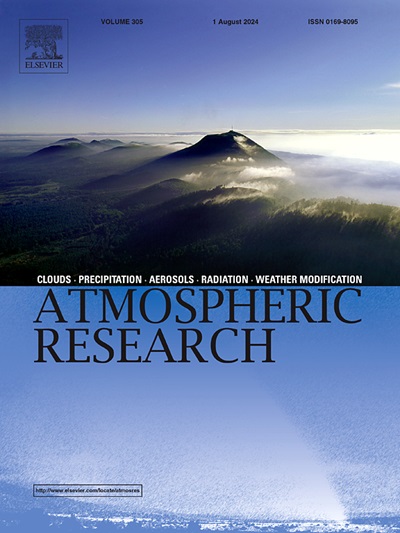Climatology, trend and correlations of aerosol, cloud and meteorology over the climatologically important monsoon and adjacent northern regions of Pakistan
IF 4.5
2区 地球科学
Q1 METEOROLOGY & ATMOSPHERIC SCIENCES
引用次数: 0
Abstract
Quantifying changes in aerosols, cloud characteristics, and their correlations on both spatial and temporal scales is essential for understanding future climate changes. In this study, 11 years (2009–2019) of aerosol, meteorological, and cloud datasets are analyzed to evaluate climatology, trends, and their relationships over the climatologically important core monsoon- (R1) region and the adjacent high-altitude northern (R2) region of Pakistan. The study utilizes Modern-Era Retrospective Analysis for Research and Applications version 2 (MERRA-2) data for aerosol optical depth (AOD) and Angstrom Exponent (AE), CLARA-A3 data for liquid cloud properties such as cloud droplet effective radius (CER), cloud optical thickness (COT), cloud droplet number concentration (CDNC), cloud geometrical thickness (CGT), and liquid water path (LWP), and ERA-5 data for meteorological variables at a spatial resolution of 0.25° × 0.25°. Negative trend in AE over both the R1 and R2 regions (−5 % and −10 %) are observed which could be due to deforestation, increasing temperature, and changing precipitation patterns that may disturb the dust activity and monsoon circulations. The concurrent increasing trend in AOD (12.4 %) and Aerosol Index (AI) (3.2 %) is observed over R1, likely driven by rapid urbanization, industrialization, and biomass burning. Conversely, a decreasing trend in AOD (−7.0 %) and AI (−14.14 %) is observed over R2, possibly due to anthropogenic emission control policies in China, that reduces aerosol inflow in remote areas, including the high-altitude R2 region. Positive trends are observed in CDNC, CER, CGT, COT, and LWP, with percent changes of 9.2 %, 20.7 %, 4.06 %, 6.7 %, and 10.7 % over R1 region and 34.7 %, 5.4 %, 16.98 %, 21.9 %, and 24.8 % over R2 region, respectively. Meteorological variables, including mixing ratio (q), geopotential (z), convective available potential energy (CAPE), horizontal wind speed at 10 m above the surface (si10m), dew point temperature at 2 m (d2m) and temperature at 2 m (t2m), show positive trends over both R1 and R2 regions. Correlation analysis reveals positive AOD-CDNC and negative AOD-CER relationships in both regions. In contrast, AI-COT, AI-CGT and AI-LWP correlations are negative (−0.13, −0.26 and −0.20) over R1 region but insignificant weak negative AI-CGT (−5.7 × 10−6) and positive AI-COT (0.099) and AI-LWP (0.061) are observed over R2 region. The contrasting behavior of AI-COT and AI-LWP correlations can be attributed to the difference in cloud regime and meteorological conditions over the R1 and R2 regions. The results of this study provide critical insights into aerosol-cloud-meteorology interactions, with implications for regional climate modeling, monsoon variability, and future climate projections. The findings also contribute to global aerosol-cloud research by emphasizing the importance of region-specific mechanisms in shaping aerosol-cloud interactions.
气候学、趋势和气溶胶、云和气象在气候上重要的季风和邻近的巴基斯坦北部地区的相关性
量化气溶胶、云特征的变化及其在空间和时间尺度上的相关性对于了解未来的气候变化至关重要。在这项研究中,分析了11年(2009-2019)的气溶胶、气象和云数据集,以评估气候学上重要的核心季风区(R1)和邻近的高海拔北部(R2)地区的气候学、趋势及其关系。本研究利用MERRA-2(现代回顾分析研究与应用版本2)气溶胶光学深度(AOD)和埃指数(AE)数据,CLARA-A3(云滴有效半径(CER)、云光学厚度(COT)、云滴数浓度(CDNC)、云几何厚度(CGT)和液态水路径(LWP)等液体云特性数据,以及ERA-5(气象变量)数据,空间分辨率为0.25°× 0.25°。R1和R2区域的声发射均呈负趋势(- 5%和- 10%),这可能是由于森林砍伐、温度升高和降水模式的变化可能干扰了沙尘活动和季风环流。在R1期间,AOD(12.4%)和气溶胶指数(AI)(3.2%)同时呈上升趋势,这可能是由快速的城市化、工业化和生物质燃烧驱动的。相反,AOD(- 7.0%)和AI(- 14.14%)在R2上呈下降趋势,这可能是由于中国人为排放控制政策减少了包括高海拔R2区域在内的偏远地区的气溶胶入流。CDNC、CER、CGT、COT、LWP均呈上升趋势,R1区变化幅度分别为9.2%、20.7%、4.06%、6.7%、10.7%,R2区分别为34.7%、5.4%、16.98%、21.9%、24.8%。混合比(q)、位势(z)、对流有效势能(CAPE)、地表以上10m水平风速(si10m)、2m露点温度(d2m)和2m温度(t2m)等气象变量在R1和R2区域均呈现正趋势。相关分析显示,两个地区的AOD-CDNC呈正相关,AOD-CER呈负相关。AI-COT、AI-CGT和AI-LWP在R1区域呈负相关(- 0.13、- 0.26和- 0.20),但在R2区域呈弱负相关(- 5.7 × 10 - 6), AI-COT和AI-LWP呈正相关(0.099)和正相关(0.061)。AI-COT和AI-LWP相关性的差异可归因于R1和R2地区云况和气象条件的差异。这项研究的结果为气溶胶-云-气象的相互作用提供了重要的见解,对区域气候模拟、季风变率和未来气候预测具有重要意义。这些发现还强调了形成气溶胶-云相互作用的区域特定机制的重要性,从而有助于全球气溶胶-云研究。
本文章由计算机程序翻译,如有差异,请以英文原文为准。
求助全文
约1分钟内获得全文
求助全文
来源期刊

Atmospheric Research
地学-气象与大气科学
CiteScore
9.40
自引率
10.90%
发文量
460
审稿时长
47 days
期刊介绍:
The journal publishes scientific papers (research papers, review articles, letters and notes) dealing with the part of the atmosphere where meteorological events occur. Attention is given to all processes extending from the earth surface to the tropopause, but special emphasis continues to be devoted to the physics of clouds, mesoscale meteorology and air pollution, i.e. atmospheric aerosols; microphysical processes; cloud dynamics and thermodynamics; numerical simulation, climatology, climate change and weather modification.
 求助内容:
求助内容: 应助结果提醒方式:
应助结果提醒方式:


